-

In the 1922 edition of "Taps," the senior class (the sophomores of the 1920 walkout) reflected fondly on their role in bettering Clemson.
-

In his 1923 report to the Board of Trustees, President Riggs spoke of the graduating class, who had been freshmen during the 1920 walkout. President Riggs stated that, with few exceptions, the graduating class was "more cooperative, more loyal and in general more satisfactory" than any other recent classes.
-

President Earle's 1924 report to the Board of Trustees included a laudatory section on the state of the mess hall, which was hailed as one of the best in the country.
-
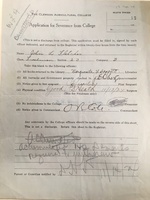
A few walkout participants, such as John L. Fletcher, requested to leave Clemson. It is unclear whether these students held irreconcilable issues with the school or if their parents did not allow them to return.
-

President Earle sent this letter indicating that the complaints of the 1924 walkout were unfounded.
-

The Board of Trustees issued a report on the 1924 walkout, in which they clearly showed an increase in quantity of food provided in the mess hall. They also included testimony from a state health inspector who lauded the Clemson mess hall as one of the best in the country.
-

Cadet Harold Witt sent this letter to his father following the 1924 walkout. He indicates that the walkout was not supported by the majority of Clemson students, and he had decided not to participate.
-

The walkout of 1924 was widely denounced. This fascinating letter was sent by James M. Cummins to President Samuel B. Earle. Cummins, of course, had been the Commandant at the center of the 1920 walkout.
-

The punishment of R. F. "Butch" Holohan, president of the senior class and captain of the football team, was the primary cause of the 1924 walkout.
-

In his 1921 report to the Board of Trustees, President Riggs expressed satisfaction with the new Department of Student Affairs and conditions in the mess hall.
-

Professor D. H. Henry, a widely popular teacher at Clemson, was tasked as the first Director of the Department of Student Affairs. His responsibilities included monitoring barracks, mess hall, and laundry conditions and to be a general advocate for students.
-

An article in "The Clemson Alumnus" described the new Department of Student Affairs, which was to be overseen by a widely popular professor, Dr. D. H. Henry.
-

In a two-day meeting during the summer of 1920, the Board of Trustees made substantial revisions to by-laws concerning the Disciplinary Committee, including instituting public trials.
-

In a two-day meeting during the summer of 1920, the Board of Trustees officially approved the creation of a Department of Student Affairs.
-

President Riggs offered his reflection of the 1920 walkout. He placed particular emphasis on the notion that college life had changed in the years following World War I. He insists Clemson had operated as an institution "for boys;" however, the Great War had turned many of Clemson's students into men. This disparity was the root cause of the walkout in Riggs' view.
-
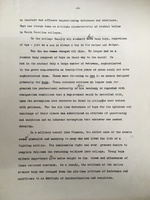
President Riggs offered his reflection of the 1920 walkout. He placed particular emphasis on the notion that college life had changed in the years following World War I. He insists Clemson had operated as an institution "for boys;" however, the Great War had turned many of Clemson's students into men. This disparity was the root cause of the walkout in Riggs' view.
-

President Riggs offered his reflection of the 1920 walkout. He placed particular emphasis on the notion that college life had changed in the years following World War I. He insists Clemson had operated as an institution "for boys;" however, the Great War had turned many of Clemson's students into men. This disparity was the root cause of the walkout in Riggs' view.
-

In the days following the Board of Trustees' investigation, newspapers around the state reported on the Board's findings. The Board sided with the school administrators, but stated their intention to concede on some of the students' demands.
-

President Riggs received numerous correspondence expressing support. This letter is notable as it was sent from W. S. Currell, president of Clemson's peer institution, the University of South Carolina.
-
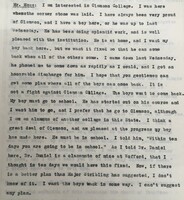
Several parents testified during the Board of Trustees' investigation. Here, Mr. Moss indicates that his son's desire to return to Clemson and seems to believe that his son was motivated to leave campus due to peer pressure.
-
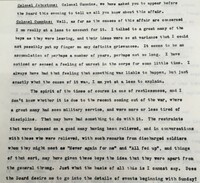
The Commandant of the Corps, Lt. Col. Cummins, testified during the Board of Trustees' investigation. He stated his belief that the walkout was due to postwar angst.
-
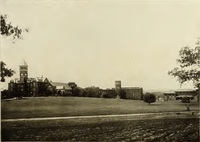
A photograph of "Main Hall" at Clemson College, taken from the 1920 edition of "Taps," the school yearbook.
-

The freshman and sophomore classes drafted a formal petition with several demands including improved mess hall conditions, revisions to the Disciplinary Committee, and reinstatement without punishment of all walkout participants.
-
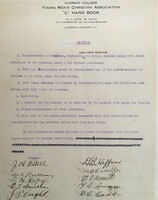
The freshman and sophomore classes drafted a formal petition with several demands including improved mess hall conditions, revisions to the Disciplinary Committee, and reinstatement without punishment of all walkout participants.
-

Cadet Cullum testified during the Board of Trustees' investigation. One of the most prominent features of his testimony was his imparting of student demands, including the institution of public trial for disciplined students.
























